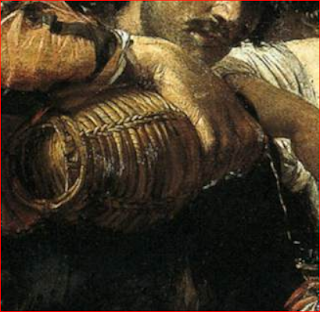Philocale, from Paris, sells on 30 January 2016 an "Italian School, middle of the 17th century" Feast of Bacchus, a large panel (142 by 217) estimated at 4,000 to 7,000 Euro.
While I couldn't find a direct example for this work, it looks a lot more like the work of a follower of Valentin de Boulogne than it resembles an Italian work (or, from the other side of such compositions, the works of Gerrit van Honthorst and the like).
It's a good composition with some very well painted aspects (the two women on the left), but also some rather dreadful bits (like the woman on the right, with the claw(?) on her shoulder), so the chance that it is a real De Boulogne seems slim (or else it has suffered very badly over the centuries).
The musician to the right is comparable to the one on the above De Boulogne examples, although he looks slightly more "Dutch" here to my eyes.
The above work from the Louvre also shows a comparable composition and mood to the example for sale, and matches in details like the drinking vessel. Obviously the one from the Louvre is a much better painting though. Other things like the clothing also point to a comparable date and period of origin.
Oh, and "pour la petite histoire", a previous owner seems to have been a bistro (either called "Romain", or in Rome), as seen here.
And for the record; everywhere above that I have used "De Boulogne", one can just as well say "Nicolas Fournier" or perhaps some other pupil of De Boulogne. While probably the styles of master and pupil are distinguishable in an original, it is for me impossible in such a copy or "inspired by" work like this one. The position of the lute player in the above Tuornier is probably closer to the one for sale than any of the Boulognes I have seen and shown, and the second example shows similar drinking vessels as the one I used to make the comparison to De Boulogne as well. Tournier seems to prefer to have the table pointing towards the watcher with one corner, while De Boulogne prefers to place it parallel, just like in the work for sale... Which bit is meaningful, which is just coincidence? The general origin of (the original of) our work seems clear though.
Value of the work for sale? It is huge, but damaged and badly painted in places. Overall it is interesting, may have art historical value if it would e.g. be a copy after a lost or unknown De Boulogne painting, but probably isn't a sleeper in its own right. 5,000 Euro, or mid-estimate, should be about right.










No comments:
Post a Comment